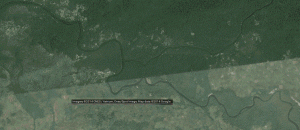
This is an aerial photo of a river just like any other river – except that this rather innocuous looking waterway lends its name to the deadly Ebola virus disease (EVD) which is currently spreading through West Africa.
News agencies are reporting that over 1400 people have died since the start of the outbreak, making it the worst known outbreak of the disease in history – and, to give you an idea of how rapidly the disease is spreading and killing, the number of fatalities has doubled since I first considered writing this blog article only a few weeks ago.
The first ever cases of EVD were recorded in 1976 in Nzare, Sudan (now South Sudan) and in a small village along the Ebola River in Democratic Republic of Congo. Five species of Ebolavirus exist: Bundibugyo ebolavirus, Zaire ebolavirus, Taï Forest ebolavirus and Sudan ebolavirus are associated with EVD in Africa, but the fifth species Reston ebolovirus has not caused EVD in humans thus far.

Fruit bats are the natural hosts of the virus and it is transmitted to humans either directly from bats or indirectly via other intermediary wild animals (such as monkeys). Fruit bats are a delicacy in rural parts of West Africa and one of the steps taken to curb the current outbreak is banning the consumption of fruit bats – unfortunately it has been reported recently that the ban has been unheeded by many in Guinea. Transmission is through contact with bodily fluids of infected animals. The virus can then pass from human to human (again through bodily fluids such as blood, semen and mucus) resulting in outbreaks. The current outbreak is thought to have started from a toddler’s chance encounter with a fruit bat in Guinea.
In humans, it can take anywhere from two days to twenty one days for the symptoms to manifest after initial infection. The symptoms are characterised by the sudden onset of fever, muscle pain, weakness, sore throat and headaches. This is then followed by vomiting, diarrhoea, rashes and impaired liver and kidney functions. In some cases, all these symptoms are further compounded by internal and external bleeding, which was why EVD used to be called Ebola Haemorrhagic Fever. According to the World Health Organisation (WHO), there can be a fatality rate of up to 90 % during outbreaks of EVD, although the fatality rate for the current outbreak is thought to be around 55%.
The first cases of the current outbreak occurred in February 2014 in Guinea, and since then the outbreak has spread to Liberia, Sierra Leone, and Nigeria, which is one of the most densely populated countries in Africa. New cases of EVD have been confirmed in a remote location of the Democratic Republic of Congo recently, but these might be unrelated to the outbreak in West Africa. For more details on how the outbreak developed, please visit the Medicin Sans Frontieres (MSF) timeline.
There is currently no vaccine or approved cure for EVD and treatment involves intensive supportive care. However, in a few cases involving care workers who have contracted the disease, an experimental drug ZMapp has been administered with some positive results. The drug was given to two US doctors who recovered fully from EVD. British nurse, Will Pooley is currently receiving treatment in a London hospital but the outcome of his treatment is not yet known. On the other hand, one of three Liberian doctors that had been receiving treatment with Zmapp has died, despite initially responding well to the drug. The use of the drug poses important ethical questions: is it ethical to use a drug that has not been fully approved? And equally, as there is a limited supply, who gets the treatment and who does not?
The WHO published a roadmap to scale up the international response to the outbreak on 28th August 2014. Despite the efforts of all parties working to control the outbreak and treat infected patients, MSF say that it could take 6 months to control the outbreak. The outbreak is putting a great burden on the region’s health care system and containment efforts are hampered by lack of information and suspicion of health workers, making people reluctant to seek medical assistance. In addition to the health burden, there is also concern for the social and economic impact that the outbreak has already had (there has been civil unrest in Liberia) and will continue to have on affected countries.
About the blog author:
Dr Srimathy Sriskantharajah (@srimsris) is the Journal Development Manager for Parasites & Vectors and Malaria Journal and is employed by Open Access publisher BioMed Central. She has an academic background in environmental sciences and microbiology.

Update: The British Nurse Will Pooley has now been discharged from hospital after being given the all clear from doctors. https://www.theguardian.com/society/2014/sep/03/british-ebola-patient-will-pooley-discharged-hospital